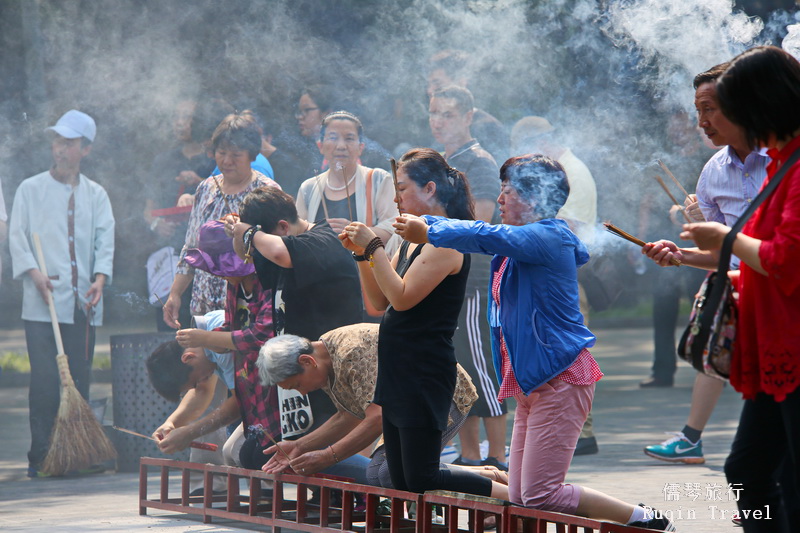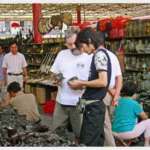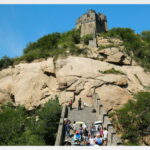Welcome to the Lama Temple, or Yonghe Temple, a beacon of Tibetan Buddhism in Beijing’s heart. This “A Comprehensive Guide to Lama Temple” provides you with all the necessary information to plan your visit to this majestic temple, known as Harmony and Peace Palace Lamasery,
Yonghe Temple, often called “Yonghegong” in Chinese, meaning “Harmony and Peace,” reflects its tranquil ambiance and spiritual significance. For travelers, this temple is a must-visit site, ranking high alongside Beijing’s Forbidden City and Temple of Heaven. Discover the rich history that dates back to when Emperor Yongzheng called it home, and its evolution into a revered lamasery.
Why Lama Temple?
Yonghe Temple is not just a testament to architectural grandeur but also a repository of cultural and spiritual treasures. Here are compelling reasons to include it in your Beijing itinerary:
- World’s Largest Sandalwood Buddha: The temple houses an awe-inspiring sandalwood Buddha statue, renowned for being the largest of its kind globally. This masterpiece symbolizes peace and spirituality, drawing visitors from across the world.
- Bronze Buddhas of Three Times: These magnificent bronze statues represent the Buddhas of the past, present, and future. They embody the continuum of time and the eternal essence of Buddhist teachings.
- 500-Arhat-Hill: This remarkable artistic creation features 500 unique Arhat figures, each symbolizing a different aspect of Buddhist philosophy.
Yonghe Temple’s unique status is highlighted by its yellow glazed tile roofs, a color traditionally reserved for imperial use, signifying its importance in Beijing’s religious landscape. The temple has played a pivotal role in the intersection of religion and politics, serving as a bridge between the Qing Dynasty’s central government and Tibet. Its influence in spreading Tibetan Buddhist culture is unparalleled, making it a key destination for understanding China’s religious diversity.
Best Times to Visit Lama Temple
Selecting the right time to visit the Lama Temple can greatly enhance your experience. While the temple welcomes visitors year-round, certain periods offer a more pleasant and insightful visit.
Ideal Season: The months from April to October, with their warmer weather, mark the peak visiting season. However, for a perfect blend of comfortable climate and fewer crowds, mid-October to late November is ideal. The autumn’s mild temperatures and vibrant foliage create a serene backdrop for exploring.
Festival Times: Visiting during significant Tibetan festivals, such as the Chinese New Year or the Dayuan Invocation Dharma Assembly, presents a unique opportunity to witness the temple in its full spiritual fervor. However, these periods also attract larger crowds.
Weekday Visits: To avoid weekend and public holiday rushes, consider a weekday visit. This ensures a more tranquil experience, allowing you to immerse yourself in the temple’s spiritual ambiance without the distractions of a large crowd.
How to Get to Lama Temple
Reaching Lama Temple is convenient, with multiple transportation options available:
By Subway: The most efficient way to reach Yonghe Temple is by subway. Take Line 2 or Line 5 and alight at “Yonghegong” (Lama Temple) Station. For Line 2, use Exit C; for Line 5, Exit F is preferable. Once you exit, a short walk along a sidewalk, lined with interesting shops and traditional incense sellers, leads you directly to the temple’s entrance.
By Bus: Several bus routes serve the area around Yonghe Temple. Buses 13 or 684 will drop you at Guozijian Station, while buses 116 or 117 stop at Yonghegong Lama Temple Station. Other options include buses 2, 18, 44, 62, 606, 800, 858, or 909, alighting at Lama Temple Bridge East Station.
By Taxi: For a direct route, taking a taxi is a convenient option. Simply show the driver the phrase “请带我去雍和宫” (Please take me to the Lama Temple), and they will know your destination.
Address: 12 Yonghegong Dajie, Dongcheng District, Beijing. The temple’s prominent location makes it easily identifiable. 北京市东城区雍和宫大街12号.
Opening Hours and Entrance Fees
Planning your visit to Yonghe Temple includes knowing its operating hours and ticketing details:
Operating Hours:
- April to October: 9:00 AM to 4:30 PM
- November to March: 9:00 AM to 4:00 PM
Visiting hours might vary slightly during special festivals or events, so it’s wise to check in advance.
Entrance Fee:
- CNY 25 (approximately US$4) per person
- Free admission for children under 1.2 meters (approximately 3.9 feet)
Additional Tips:
- The temple is a popular spot for locals to seek blessings, particularly around traditional festivals and important examinations. These periods can be incredibly busy, offering a unique cultural experience but potentially less peaceful.
- English-speaking guides and audio guides are available for rent. Inquire at the ticketing booth while purchasing your entrance ticket.
This information ensures a smooth visit, allowing you to immerse yourself in the spiritual ambiance of Lama Temple without any surprises.
Five Major Buildings in Lama Temple
Yonghe Temple’s architectural splendor is epitomized in its five primary buildings, each separated by courtyards and decreasing in height from south to north. These buildings are not just structures; they are the carriers of history and spirituality.
The Yonghe Gate 雍和门
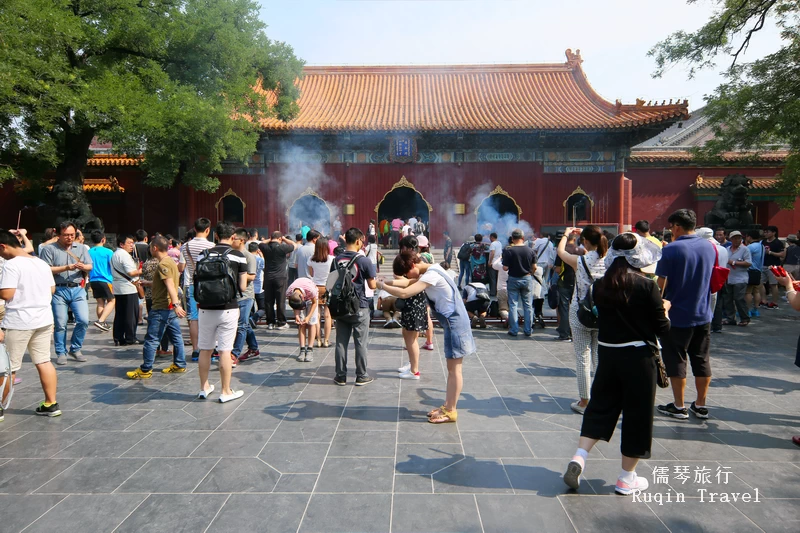
This grand entrance, once the main gate to the temple, sets the tone for what lies ahead. Housing the four heavenly kings and the big-bellied Maitreya Buddha, it radiates an air of serenity and reverence. The presence of bronze lions and the Buddha Maitreya, perched on a golden lacquer throne, immediately immerses visitors in the temple’s spiritual essence.
The Yonghe Gong Main Hall 雍和宫
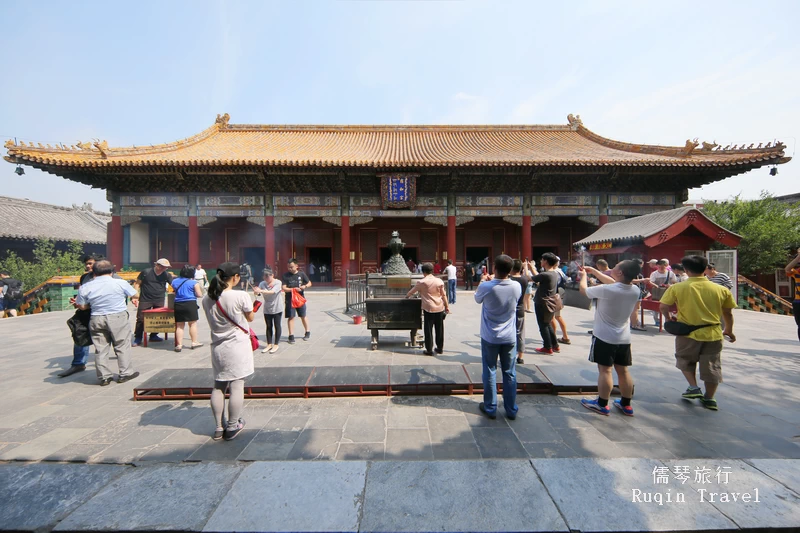
Moving north, the Yonghe Palace stands as the temple’s centerpiece. It houses three significant bronze Buddhas representing the past, present, and future. The hall also contains 18 Arhats, symbolizing protection. This hall’s rich history as a meeting place for Prince Yongzheng with officials adds a layer of historical significance.
The Yongyou Hall 永佑殿
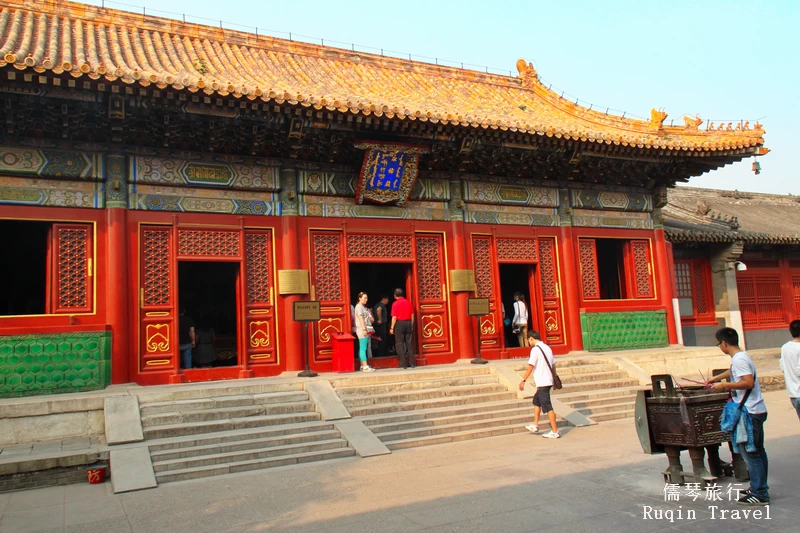
This hall, previously Prince Yongzheng’s residence and later a site for emperor’s coffins, now hosts statues of Amitayus, Bhaisajyaguru, and Simhanada. It reflects the temple’s transition from a royal residence to a spiritual sanctuary.
The Falun Hall 法轮殿
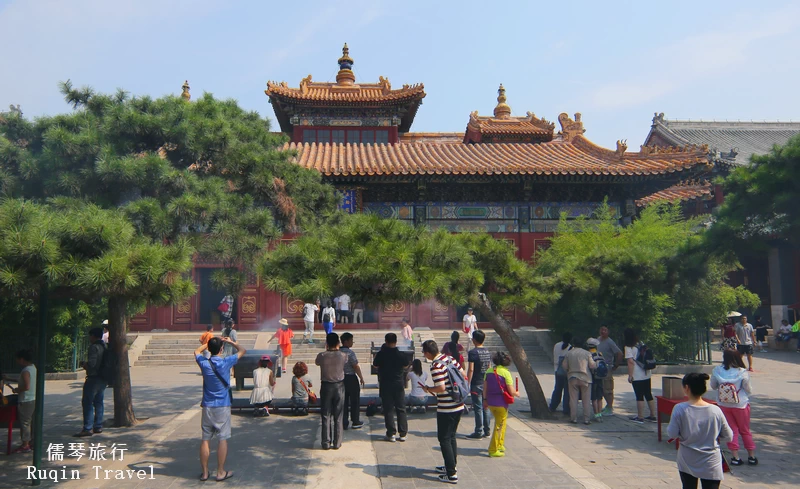
Falun Hall, adorned with a mix of Chinese and Tibetan architectural styles, was once the Emperor’s wives’ living quarters. Now, it features a large statue of Tsong Kha-pa and the remarkable Five Hundred Arhat Hill carving. This hall is a center for chanting and religious ceremonies.
Wanfu Pavilion 万福阁
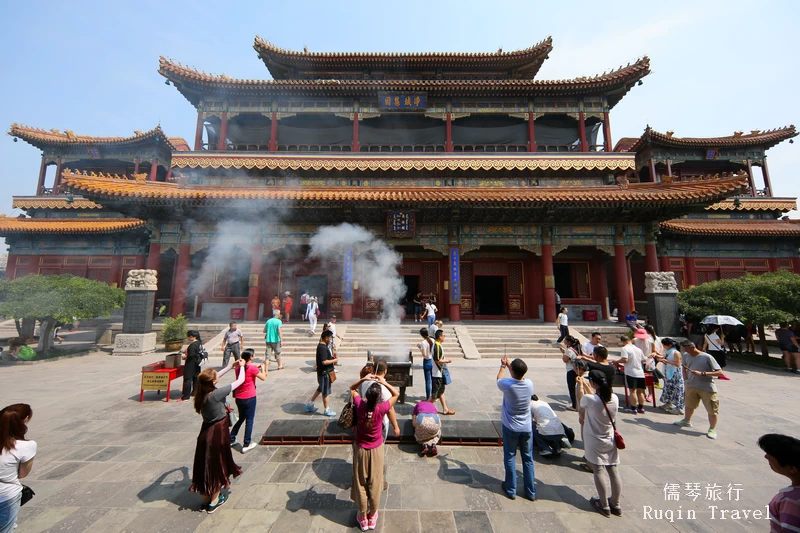
The highest and most northern building in the temple, it houses the world’s largest wooden Buddha statue, carved from a single sandalwood log. The sheer size and craftsmanship of the Maitreya Buddha statue in this pavilion are awe-inspiring.
These buildings, each with its unique history and spiritual significance, form a harmonious and enlightening journey through the Lama Temple.
Activities and Events in Lama Temple
Lama Temple is not only a historical and architectural marvel but also a vibrant center for cultural and religious activities. Here are some significant events and activities that you can experience:
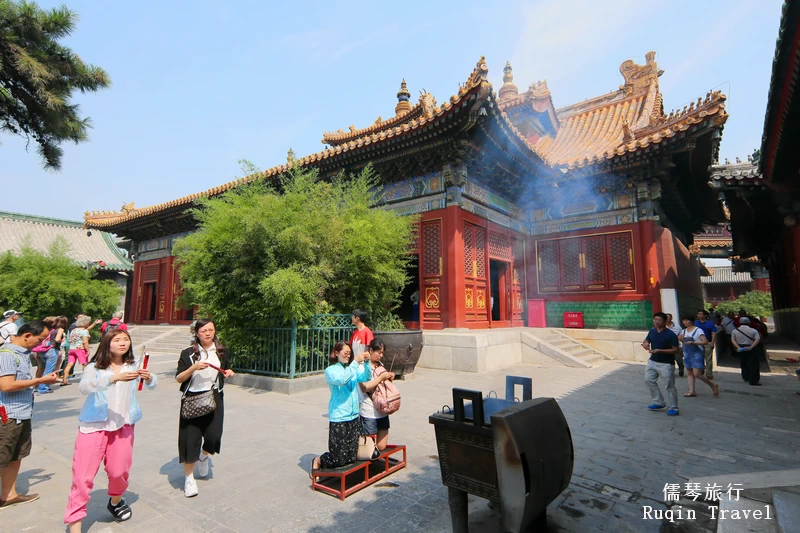
- Dayuan Invocation Dharma Assembly (February/March): This profound festival, commemorating Sakyamuni, the founder of Buddhism, is marked by a week of sacred rituals. Monks engage in continuous scripture chanting, praying for peace and prosperity. Typically held from mid-February to mid-March, this assembly attracts devotees and visitors, offering a deep dive into Tibetan Buddhist traditions.
- New Year Ceremony Dharma Assembly (January/February): As the Chinese New Year dawns, the temple comes alive in the early hours with monks chanting prayers to welcome the new year. This ritual, brimming with devotion and spirituality, draws crowds eager to start their year with blessings. The festival usually falls between January 21 and February 20, according to the lunar calendar.
Besides these festivals, regular activities like daily prayer sessions, scripture readings, and meditation classes offer insights into the monks’ life at the temple. These events provide a unique opportunity to witness the living traditions of Tibetan Buddhism and immerse oneself in a serene spiritual atmosphere.
How to Plan Your Visit to Lama Temple
A well-planned visit to Lama Temple ensures a fulfilling experience. Here’s a recommended tour route to help you navigate through this spiritual sanctuary:
- Start at Yonghe Gate Hall: Begin your journey at the temple’s southern entrance, absorbing the majestic presence of the Maitreya Buddha and the Four Heavenly Kings.
- Proceed to Yonghe Gong Hall: Experience the essence of Lama Temple in its main hall, admiring the trio of bronze Buddhas symbolizing different time periods.
- Explore Yongyou Hall: Discover the hall’s transition from imperial residence to a place of eternal protection for emperors.
- Visit Falun Hall: Delve into the fusion of Chinese and Tibetan architectural styles, and witness the significant Five Hundred Arhat Hill carving.
- Conclude at Wanfu Pavilion: Stand in awe of the world’s largest wooden Buddha statue, a true marvel of craftsmanship and devotion.
Between visits to these halls, take time to explore the side buildings and courtyards, each offering unique insights into the temple’s history and cultural significance.
Nearby Attractions
After exploring Lama Temple, extend your journey by visiting these nearby attractions, each offering a unique glimpse into Beijing’s rich history and culture:
- Temple of Confucius: Just a short walk from Lama Temple, this temple dedicated to the great philosopher Confucius offers a peaceful retreat. It’s a place steeped in history and education, reflecting ancient Chinese wisdom.
- Guozijian (Imperial Academy): Explore China’s oldest imperial academy, where scholars once prepared for their imperial examinations. The architecture and the spirit of learning here are remarkable.
- Guijie Street: A paradise for food lovers, this street is lined with a variety of restaurants offering authentic Chinese cuisine. A perfect spot to satiate your hunger after a day of exploration.
- Wudaoying Hutong: Immerse yourself in the charm of old Beijing by strolling through this historic alley, brimming with quaint shops and cafes.
- Shichahai: This scenic area, known for its beautiful lakes and traditional hutongs, is ideal for a leisurely evening walk.
- Ditan Park: A serene park, famous for its temple fairs, especially during the Spring Festival. It’s a great place to experience local traditions and relax.
Practical Tips for Visitors to Lama Temple
To ensure a seamless and enjoyable visit to Lama Temple, consider these practical tips:
- Early Arrival: Aim to arrive early, preferably as the temple opens, to avoid the larger crowds that gather as the day progresses.
- Dress Respectfully: While there’s no strict dress code, wearing modest attire out of respect for the temple’s religious significance is advisable.
- Photography: While photography is generally allowed, be mindful of signs indicating restricted areas. Always be respectful and avoid using flash inside the halls.
- Language: Basic English signs are available, but carrying a phrasebook or translation app can be helpful for more detailed information.
- Local Customs: Observe and respect local customs. This includes acts like burning incense, bowing before statues, and participating in rituals.
- Stay Hydrated: Bring a bottle of water, especially during warmer months, as exploring the extensive grounds can be tiring.
- Avoid Public Holidays: If possible, plan your visit to avoid Chinese public holidays when the temple is especially crowded.
Following these tips will enhance your experience and allow you to fully appreciate the spiritual and cultural significance of Lama Temple.
Lama Temple, a remarkable blend of history, spirituality, and architectural beauty, offers a unique and enriching experience in the heart of Beijing. As you walk through its serene courtyards and grand halls, each step takes you deeper into the rich tapestry of Tibetan Buddhism and Chinese imperial history.
Whether you’re seeking spiritual insight, cultural enrichment, or just a peaceful retreat from the bustling city, Yonghe Temple stands as a testament to the enduring legacy of China’s religious and cultural diversity. Remember to embrace the tranquility, respect the customs, and immerse yourself in the profound peace that this sacred space offers.
More Beijing Travel Guides
Planning your Beijing tour? Our “Beijing Travel Guide“ section offers essential advice to help you navigate the city like a pro. From transportation tips and local customs to insider recommendations for hidden gems, these travel tips will ensure you have a smooth, enjoyable, and unforgettable experience in China’s vibrant capital. Let us guide you through the best practices for exploring Beijing with confidence!

